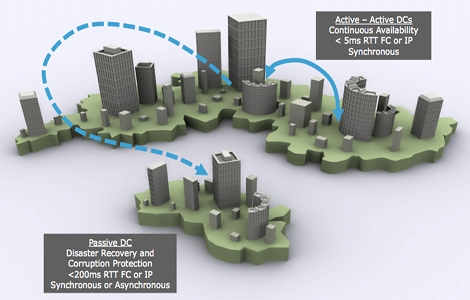
Active-Active (VPLEX) or Active-Passive (RecoverPoint)?
Posted on January 11, 2012 by TheStorageChap in Data Center, RecoverPoint, Replication, VPLEXSo I am responsible for, at least on face value, two competing products. If my own hype is to be believed the future is the active-active distributed data center; so where does that leave active-passive solutions like RecoverPoint?
Well actually in two very key areas.
Firstly these solutions are complementary. RecoverPoint offers a lot more than just simple replication. Amongst other things it enables long distance replication over low bandwidth links and granular corruption protection allowing you to roll back to a point in time immediately before a corruption or deletion took place.
On the flip side distributed active-active data centers are separated over relatively short (100-500KM) distances, require high bandwidth, low latency connectivity and if you have a corruption event at the logical level it will effect all copies of the data.
As a consequence many customers exploring active-active continuous availability are also still looking at traditional disaster recovery and high availability options. For many this is a three site approach with two datacenters relatively close together offering continuous application availability and then a third site, the other side of the world if required, offering a traditional DR scenario.

This is exactly the reason why over the coming few months you will see announcements from EMC in regard to exciting integration between both RecoverPoint and VPLEX. Enabling both a three-site (active – active – passive DR) solution and local corruption protection for VPLEX virtual volumes.
Secondly, for many organizations, the infrastructure does not exist, the cost is too high, or the business does not require the protection afforded by an active-active distributed data solution. For those organizations RecoverPoint can offer high availability with limited disruption enabling piece of mind for both the storage and application administrators.
Discussion · No Comments
There are no responses to "Active-Active (VPLEX) or Active-Passive (RecoverPoint)?".No one has posted a comment on this post yet. Start the discussion!
Leave a Comment